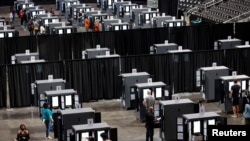Online misinformation and false claims of voter fraud by former President Donald Trump and his allies have drastically eroded public confidence in the integrity of American elections. The way Americans vote, and the equipment they use, varies widely, with some methods more vulnerable to efforts to shake that confidence.
Heading into the 2022 midterm elections, election experts say the shift in most states to hybrid voting systems — paper ballots counted by electronic machines — could give voters greater confidence.
Electronic voting machines
The United States invested heavily in paperless electronic voting machines after the disputed presidential election between Democrat Al Gore and Republican George W. Bush in 2000 shook election officials’ confidence in paper ballots.
By 2006, the proportion of registered voters using paperless machines had increased, although hand-marked paper ballots that are then scanned by electronic tabulators remained the most popular. Over the next decade, about a third of all votes were cast on electronic direct-recording machines.
These electronic voting machines store the votes in their memory. The lack of a physical record to support electronic voting means that election officials must trust that machines will not malfunction and change or lose a vote, that poll workers will not inadvertently alter votes, or that machines will not be hacked. Douglas Jones said. , a retired University of Iowa computer science professor who spent decades studying the use of computers in elections.
In 2016, about 22% of registered voters lived in jurisdictions that used electronic voting machines without paper trails, according to data from Verified Voting, a US nonprofit organization that promotes the use of secure technology in election administration. .
By 2020, fewer than 9% of registered voters nationwide lived in jurisdictions that used electronic voting machines without paper trails for all voters, the lowest number since data first became available in 2006. This The change reflected growing concern among election officials about foreign interference in the election. and the need to have some way of auditing the accounts.
For the November midterm elections, that number is expected to drop to around 5%, according to data from Verified Voting.
Counties in six states still use paperless voting machines. Most are in solidly Republican or Democratic congressional districts, lessening the likelihood of a contested election.
However, there are six electoral districts that are considered at least somewhat competitive and use electronic voting machines without paper records: New Jersey’s 2nd, 3rd, 5th, and 7th Wards; the first district of Indiana; and the 15th district of Texas
paper tickets
The United States, like many countries, primarily uses paper ballots to vote. Nearly 70% of registered voters live in jurisdictions that primarily use hand-marked paper ballots, according to data from Verified Voting.
About 23% of registered voters live in jurisdictions that primarily use machines called ballot marking devices. These allow voters to make their selections electronically and also produce a paper record that can be scanned by another device.
The extent to which voters use digital technology to cast their vote has changed over time. Paperless electronic voting, touted for its ability to quickly and accurately count votes, greatly declined in popularity in the United States and European countries from the mid-2000s onward.
Countries have turned to paper as the most secure way to audit their elections and detect potential vote rigging. To be sure, machines remain an integral part of the electoral process, even when votes are cast on ballot paper. Optical scanning tabulators count the results.
Election experts say paper ballots help secure elections because they allow voters to verify how they voted and officials to check the results in post-election audits.
Georgia illustrates the importance of having a paper voting record. The state had used paperless voting machines for several years. But just before the 2020 presidential election, he replaced his equipment with ballot-marking devices, the machines in which voters make their selections electronically and can then review them on a printed paper ballot, which is then scanned and tabulated by a computer. different machine.\
Trump has disputed the results and falsely claims there was widespread improprieties and fraud in the states he lost to his Democratic opponent Joe Biden. However, because there were paper ballots, election officials in Georgia were able to manually count the votes and confirm that Biden had won the state.
Vote tabulation systems
The push toward paper doesn’t mean machines are disappearing from polling places. Almost everyone still uses machines to tabulate paper ballots. Trump and his allies falsely claim that tabulators in some 2020 races were rigged to shift votes from Trump to Biden.
They are pushing for the machines to be scrapped entirely and for ballots to be counted by hand, which election officials say is a logistical failure. The claims have been thoroughly investigated and debunked.
Still, allegations of voter fraud have sown widespread distrust in the election, with an ABC/Ipsos poll in January finding that only about 20% of the American public have much confidence in the electoral system.
Connect with the Voice of America! Subscribe to our channel Youtube and turn on notifications, or follow us on social media: Facebook, Twitter and Instagram.














